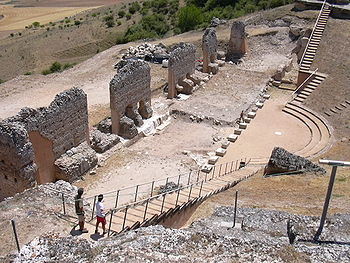
Theatre of Clunia Sulpicia
Encyclopedia

Roman theatre (structure)
The characteristics of Roman to those of the earlier Greek theatres due in large part to its influence on the Roman triumvir Gnaeus Pompeius Magnus. Much of the architectural influence on the Romans came from the Greeks, and theatre structural design was no different from other buildings...
in the ancient city of Colonia Clunia Sulpicia, in what is now northern Spain. Built on a hill called Alto de Castro (at a height of 1000 meters), it is located between the modern-day villages of Coruña del Conde
Coruña del Conde
Coruña del Conde is a village and municipality in the southern province of Burgos, Castile and León Spain. The Arandilla River runs through it....
and Peñalba de Castro, in the south of the province of Burgos.
The edifice was built under the reign of Emperor Tiberius
Tiberius
Tiberius , was Roman Emperor from 14 AD to 37 AD. Tiberius was by birth a Claudian, son of Tiberius Claudius Nero and Livia Drusilla. His mother divorced Nero and married Augustus in 39 BC, making him a step-son of Octavian...
to monumentalize the most important city, along with Asturica Augusta, of the Douro
Douro
The Douro or Duero is one of the major rivers of the Iberian Peninsula, flowing from its source near Duruelo de la Sierra in Soria Province across northern-central Spain and Portugal to its outlet at Porto...
basin. The city was in the province of Hispania Citerior Tarraconensis
Hispania Tarraconensis
Hispania Tarraconensis was one of three Roman provinces in Hispania. It encompassed much of the Mediterranean coast of Spain along with the central plateau. Southern Spain, the region now called Andalusia, was the province of Hispania Baetica...
The theatre is the most significant structure to survive at Clunia
Clunia
Clunia was an ancient Roman city. Its remains are located on Alto de Castro, at more than 1000 metres above sea level, between the villages of Peñalba de Castro and Coruña del Conde, 2 km away from the latter, in the province of Burgos in Spain...
. Carved out of rock, it had a capacity of 10,000 spectators, which made it one of the biggest of its time in Hispania
Hispania
Another theory holds that the name derives from Ezpanna, the Basque word for "border" or "edge", thus meaning the farthest area or place. Isidore of Sevilla considered Hispania derived from Hispalis....
. It was intended to house performances of theatrical works of the classical period.

